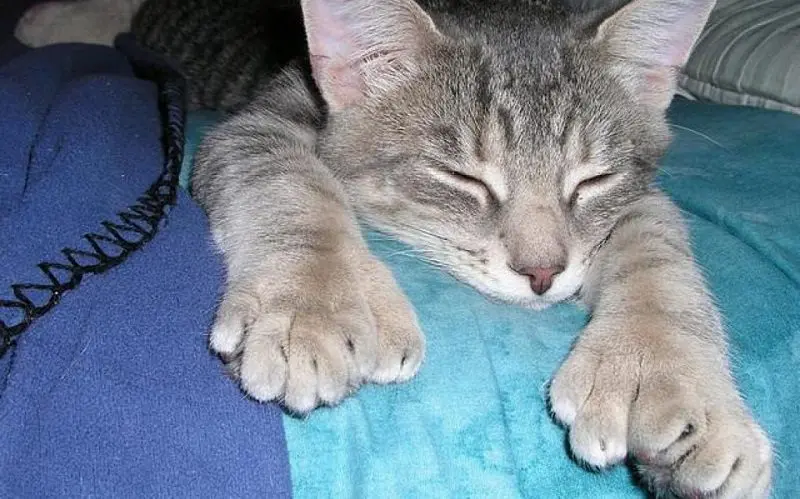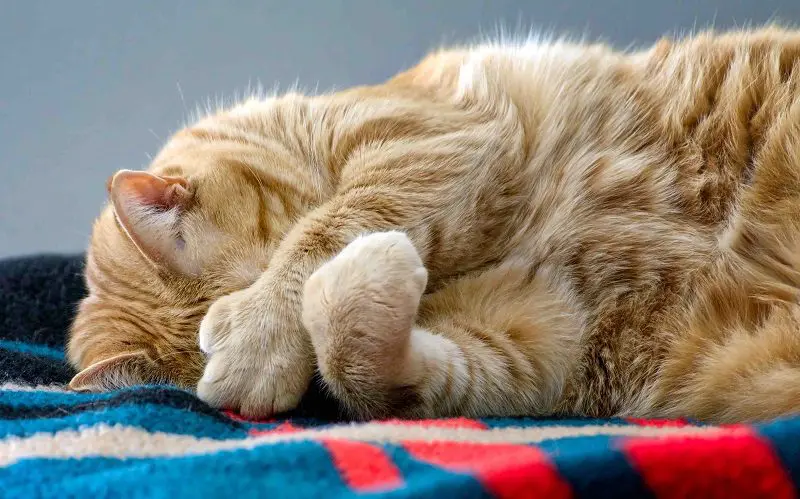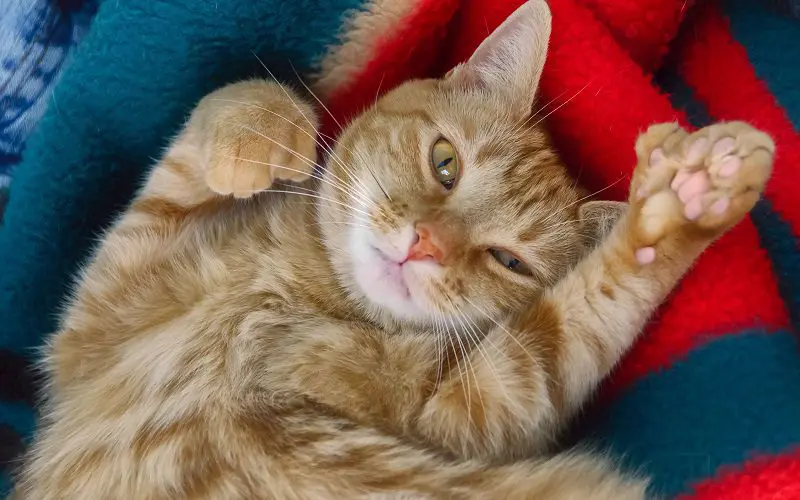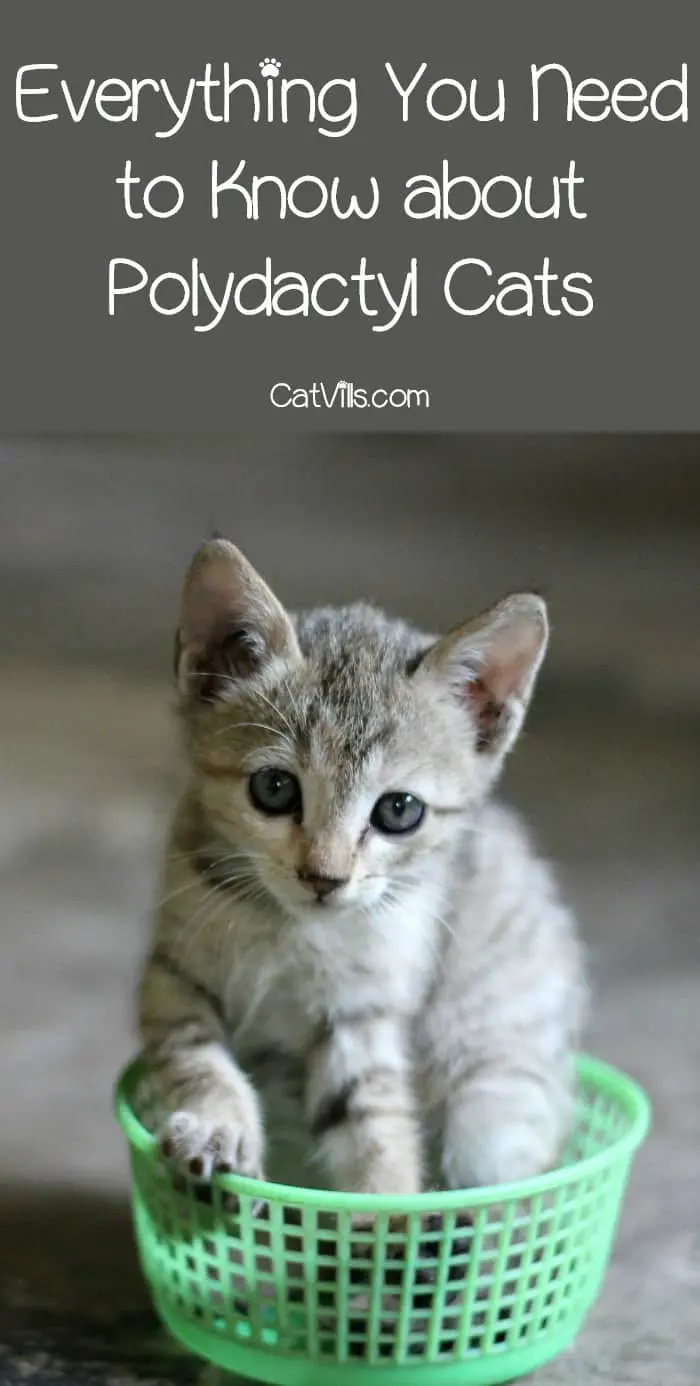Last Updated: 2 months ago
Polydactyl cats are, strictly speaking, genetic mutations. Their little paws are the result of their genes going haywire in utero, resulting in paws with too many toes.
I have seen several questions regarding polydactyl cats and what, if any, specific health issues are related to them.
We’ll address the disorder and also talk about the dangers—or, in this case, lack of danger—associated with the mutation.
Take a peek into the fascinating world of genetic mutation in cats. Here, extra toes turn ordinary animals into miracles on their paws!
History of Polydactyl Cats

Extra toes on the paw are a genetic mutation, so the origin of these cats is not known exactly. However, they have been popular for a long, long time.
The general consensus is that Bostonian sailors vigorously promoted this mutation. The sailors believed that, in addition to making the cats better climbers and mousers, the extra toes were also a good luck charm.
This history of being pampered could be why most polydactyl cats have such excellent personalities.
Of course, that is pure conjecture.
Polydactyl Cats: 10 Must-Know Facts
Imagine a cat with only the usual 18 toes but a whole set of extra toes. And thanks to them, she is ready to conquer the world, one extra toe at a time.
These unique cats have a genetic trait that endows them with a particular skill. They have more toes than average cats. But there are other exciting features about these kitties.
We will uncover the secrets behind the personalities of polydactyl cats. We will reveal ten fascinating facts that will make you look at these feline friends in a new light.
The magical world of polydactyl cats is going to mesmerize you. Find out what makes their paws genuinely extraordinary!
1. Polydactyly is a genetic mutation

Polydactyly is a fancy word for extra toes. But it’s like an incredible secret hidden in a cat’s genes. It happens when a cat has an unexpected mutation.
It makes its paws stand out from the crowd. Instead of the usual toes, polydactyl cats show off more toes. It gives them a charming and unique look.
This genetic twist is a natural and fascinating phenomenon. It’s like a particular trait passed down from furry ancestors. Have you noticed a cat with extra toes on its hind legs?
Then you’ve witnessed the magic of polydactyly. It is where genetics adds extra charm to our feline friends.
2. Common in Certain Breeds
Extra toes are not just a random feline surprise. You can often find this genetic mutation in certain breeds of cats.
Polydactyly is more common in certain cat families, becoming a common trait. It can often be found in breeds such as the Maine Coon, Hemingway, and American Bobtail.
It’s like a secret handshake among those cool cat clubs. So, have you noticed a cat with extra toes? There’s probably a good chance it belongs to one of these polydactyl breeds.
It’s like a different twist in the genetic mix. It makes these breeds even more special and paw-awesome!
3. Good Climbers

Polydactyl cats aren’t just fancy-looking with extra toes. They’re also agile climbers. These extra toes act like little hooks.
It makes it easier for them to navigate the vertical world. Imagine a furry explorer with extra toes confidently conquering peaks. They’re like furry mountain climbers.
This cool climbing ability isn’t just a demonstration; it’s part of their natural skills. So, don’t wonder if you have a multi-fingered friend living in your home.
It can turn your bookshelves into your playground. These feline acrobats use their unique paws to conquer heights with grace. It adds extra charm to their adventurous spirit.
4. Variation in Toe Numbers
Polycats are simply stunning, with their extra toes on their feet. But here’s the catch: the number of toes is not universal.
It’s like a surprise in each paw! Some polydactyl cats may have just one or two extra toes. But others may boast a whole set of extra ones. Imagine a cat with a mixed number of toes.
It turns each paw into a unique work of art. This variation in the number of toes adds a touch of whimsy. And they already have a charming appeal.
Whether or not they do a little more, these cats never lose interest in life. They demonstrate the beauty of personality one toe at a time.
5. Lucky Charms

Polydactyl cats’ personalities are like the lucky charms of the feline world. They bring a touch of magic to your home.
Their extra toes are not just cute. In some cultures, people believe they bring good luck. It’s as if each toe carries a little bit of luck!
Sailors in the past believed that these cats brought tranquility to the sea. Therefore, they became cherished companions.
Steeped in legends and stories, these cats have earned a reputation as charming companions. So, getting such a furry friend is not just about the joy of extra toes. It can add a little luck and a lot of love to your life!
6. Adaptive Advantage
Polydactyl cats with their extra toes aren’t just cute. They have a secret advantage in the cat world. Those extra toes aren’t just for show.
They provide an adaptive advantage. Imagine a cat in the wild, traversing difficult terrain with ease. And it’s all thanks to a few extra toes. They act like built-in snowshoes.
The polydactyl paws provide sure-footed mobility in areas with cold climates or uneven terrain. It makes them nature’s little survivalists.
It’s like having the perfect tool for the job. So, these adorable kittens look cute. But their unique paws also play a role in helping them overcome the hardships of the environment.
7. Health Implications

Cats with polydactyls are a cute sight, with extra toes on their feet. But it’s not just about looks; it can also affect their health.
Sure, many of them live happy lives. But having extra toes on their feet can mean they need extra care. Because of the unique structure of their paws, some such kitties may encounter problems.
These can include ingrown toenails or arthritis. Regular paw examinations and checkups become crucial to ensuring their well-being.
It’s like having a special cat with special needs. Are you lucky enough to have a polydactyl pet?
Then, a little extra attention to the health of his paws will help keep him purring. You’ll get a happy walk for the rest of your pet’s life.
8. Popularity
This kind of genetic mutation is like a rising star in the cat world. They are gaining popularity and winning hearts with their adorable extra toes.
People are falling in love with these adorable kittens, charmed by their unique and quirky looks. Social media is abuzz with pictures and stories about polydactyl pets. It turns them into internet sensations.
Their growing popularity has even led to an increase in adoptions. All because more and more people are looking for these special feline friends. It’s like having a famous cat with a built-in charm.
It is catching the attention of cat lovers all over the world. Are you looking for an adorable companion? Then this type of cat friend may be just what you need!
9. Nickname: Hemingway Cats

Have you ever heard of “Hemingway cats?” They are not a trendy breed, but a nickname for polydactyl cats.
And they became famous under none other than the legendary writer Ernest Hemingway. These special cats became part of Hemingway’s home in Key West.
Their charm left a lasting impression. This affectionate nickname is often given to all polydactyl cats’ personalities.
It’s like a secret club linking these cats to their literary heritage. The nickname adds an extra layer of personality to these already adorable kitties.
10. The World Record Holder
The title for the largest number of toes went to a cat named Jake. He boasts an incredible 28 toes.
Yes, you heard me—28! This multi-toed wonder from Canada has entered the Guinness Book of World Records.
He displayed an impressive number of toes. It’s a reminder that in the cat world, some people set records not by speed but by the charm of their many toes!
Health Considerations for Polydactyl Cats
While extra toes are a genetic mutation, there is no known association between them and any other mutations.
Unlike other congenital defects, polydactylism appears to be a stand-alone defect. In fact, these cats have no known complications that other cats normally have other than their nails.
Because of the extra toes, extra care needs to be taken with the nails. Like all cats, these fuzzballs require regular nail trimmings to keep the nails under control.
When left unchecked, the nails can overgrow and actually curl around into the paws. While this could happen with any cat, the extra toes on these guys seem to somehow contribute to the problem.
While not life-threatening, the propensity for overgrown nails in polydactyl cats leads many vets to recommend preemptive declawing of these cats to remove the possibility of any problem down the line.
Although some may view declawing as a barbaric procedure, it presents one of the better solutions in this case.
When you combine the fact that most cats will fight to the death before allowing their nails to be trimmed with the possibility of painful overgrowth in these cats, it’s often a better course of action to simply remove the problem before it starts.
Conclusion
While the extra toes on polydactyl cats are indeed a mutation, it’s not something to worry about outside of being vigilant about their nails.
This disorder has thus far never been connected to any other health issues, and all those extra toes are just plain cute.
Don’t let the numerous toes deter you if you have a polydactyl cat or are thinking about adopting one. Polydactyl cats have no significant health issues related to those extra toes, so there’s no need to worry.
Whether climbing, bringing luck, or gracing literature, these kitties add a unique paw print to the cat kingdom. Embrace the joy of these special feline friends, turning every moment into a delightful toe-tapping adventure!
Do you have experience with polydactyl cats? Share your tips below!


Dr. Linda Simon MVB MRCVS is a locum veterinary surgeon who has worked in London for the past 8 years. She graduated top of her class in small animal medicine from UCD, Dublin. She is currently a member of the Royal College of Veterinary Surgeons. Linda is the resident vet for Woman magazine and a frequent contributor to People’s Friend Magazine, the Dogzone website, Vet Help Direct and Wag! Linda also writes content for the CVS veterinary group, Vetwriter and a number of other establishments.

This is so amazing to know about the details of this cute creature. Here in India, cats as pets are not so popular, they prefer dogs but looking at such cuteness I think anyone would love to take care of her. Astonishing to know about the extra toes!
It’s such a shame that mutations in pets are so common, excessive selective breeding is nice because it creates cute pets but it’s also usually associated with genetic disorders.
Didn’t know about polydactyl cats. They are surprisingly small. Nice post for pet lovers!
I have a true polydactyl cat an extra toe,on each paw. She is just over a year old and she is a very long cat. She is just as big as my tuxedo cat. I also have a big fluffy solid black cat. His fur is 4″ Long. He is over 36″ Long when he stretches out. And I have a calico who at the age of 4 still is the size of a 6mo old kitten. She stayed in the kitten stage for 2 and a half years.
never even now there were so many different types of cats – i am sure people will feel at ease with your explanation with mutations.
I’ve never heard of polydactyl cats before. It is definitely a super cute mutation. I really hope it’s not something that puts people off when they are choosing / adopting their kitties.
This is a great post for pet lovers, I am not into pets that much..will share with some of my pet loving friends
We adopted 2 cats from the same liter when they were 5 weeks, a male and a female. We called them Ozzy and Bailey. Ozzy has nine toes on her left and 6 on the right and Bailey has 6 toes on both. They are super adorable, smart and cute. I wish I could download some cute pictures of them:).
I have a sweet Calico rescue. Cat of many toes.
6 on each front paw and 5 on each back paw.
Front feet are used a lot. She opens cabinets
and doors, can open her tightly closed food
canister. Plays with balls of all sizes every day.
I do have to cut them often. She is not a fan of
that, but puts up with it.
Kali is 12 pounds of love.
“While not life-threatening, the propensity for overgrown nails in polydactyl cats leads many vets to recommend preemptive declawing of these cats to remove the possibility of any problem down the line.
Although, some may view declawing as a barbaric procedure, it is actually an excellent solution in this case.
When you combine the fact that most cats will fight to the death before allowing their nails to be trimmed with the possibility of painful overgrowth in these cats, it’s often a better course of action to simply remove the problem before it starts.”
WRONG!!! Most cats, in fact, don’t much mind having their nails trimmed, and the ones who do can be handled safely with a little education from your vet. It is NEVER an “excellent solution” to declaw ANY cat. I have a polydactyl now, and have had them in the past. Some put up with claw trimming, some didn’t much like it. But no matter how difficult, trimming nails is ALWAYS BETTER than maiming your cat. ALWAYS!!!
Thank you I was so shocked that that remark came out of ‘Cat Viles’ Under no circumstance should any Cat have to endure being declawed. Claws are claws pain is pain and Tinker is a polydactyl extremely wonderful and the easiest Cat out of the other two for trimming.
THANK YOU for saying what NEEDED to be said !!
My polydactyl is 17 pounds (Maine coon), 1 1/2 years old and she is my baby. She loves playing catch, fetch and brings me her toys when she is bored. She sleeps in my bed and waits by the door when she hears me come home from work. I never realised how sweet cats could be. Definitely wouldn’t be a cat person if I hadn’t rescued her.
Polys need nail trims every week. She tolerates it because I began giving her gentle paw massages when I got her at about 7 mounts old. Here’s my tip; touch their paws and eventually they -should- become more tolerant to it. Cats are smart. I am leash training her now. She is able to tolerate the harness when I give her a treat. Husband, son and I cannot wait to take her for walks!
I have two adopted, mixed races cats. One of them, a white half angora cat, has only four toes, but, the fifth toe that is apart from the toes in all cats, is kind of near the toes and it is large as if it were almost like a thumb. He is very skillful with his front paws and we play with a little flat toy, like a flattened ball in such a way that is like playing ping-pong. I sit down on the floor to be at his height and I through the toy and he hits it and throws it back and I do the same and so on. He loves playing this way and he uses his paw like a racket. He also picks up little things from the floor or he picks up bits of beef with his paw, trying to use it as a hand with 5 fingers. He almost has a thumb. He is amazing!
We rescued a cat that was pregnant. All 6 kittens and the mom are polydactyl on all paws. 3 have 6 front 5 on back. 1 has 7 on both front and 5 on back. The other 2 have 8 on front on 5 on back. The mom and the one female are the little ones of the bunch, but those 5 males are big boys weighing up to 16 pounds at a year and a half old. They all can open any door or drawer in the house. They are very loving, affectionate, and playful. Also love playing with water, turn on a faucet and they all come running to see who can get the wettest. We love are furry babies.
Never Declaw a cat. It is cruel and inhumane and now it is illegal in many states. I rescued my poly when she was 3 weeks old, her mom is a stray here in the RV resort where we work and live. I was feeing the strays and the momma cat just dropped her at my feet and ran away. She comes by and makes sure I’m taking good care of her baby often. Felix my kitty grabs everything with her little hands, and she is very loving and sweet.